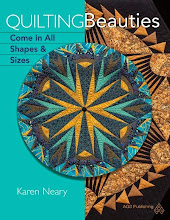"Facing Appliqué": doesn't that sound ominous?...like facing a firing squad, an angry boss, or something equally unpleasant. In truth, it's a really simple way to turn under the edges of appliqué pieces, and especially useful when working with specialty fabrics such as silk or satin. While my Father's Day antependium perks away over on one wall and my selvedge tote languishes on the table, I've started in on the communion hanging. Using a flexible ruler, I traced a gentle shape that will resemble an heraldic shield.
The background fabric is a pure white dupioni silk, and I am envisioning grapes and wheat sheaves on the front. As much as I am aware that this church likes lots of bright colour, my heart is leaning towards a monochromatic palette - gold on white. The elements will be representative rather than realistic.
Circles make great grapes. Were this cotton, I would have run a gathering thread around the edges, pulled the fabric up over a round cardboard template, and pressed under the edges. This method doesn't work well with the satin-backed crepe I've chosen for the grapes as it doesn't take pressing well so I opted to face the fabric with a lightweight fusible interfacing. To begin, I ironed a layer of this same interfacing to the crepe side of the satin. Using a Frixxion pen I traced circles on the interfacing leaving about 1/2" between each circle. (It is important to leave yourself space for a seam allowance for each circle.)
A second layer of interfacing was placed right sides together with the front side of the satin. In this case, the right side of the interfacing is the bumpy, fusible side.
I sewed completely around each circle.
Then I cut them out, leaving a scant 1/4" seam allowance around the outer edge.
With scissors, I made an X cut in the back...
...and birthed the fabric to the right side out through the opening.
Doing it this way puts the fusible side of the interfacing facing out on the back. With a press cloth, I can fuse these grapes in place temporarily. The interfacing does not adhere as firmly as fusible web, but just enough to hold the piece in place while you stitch around the edges. It saves pinning or basting, and I want as few pin holes as possible in the fabric.
Now on to the wheat...which will take some thinking.
The background fabric is a pure white dupioni silk, and I am envisioning grapes and wheat sheaves on the front. As much as I am aware that this church likes lots of bright colour, my heart is leaning towards a monochromatic palette - gold on white. The elements will be representative rather than realistic.
Circles make great grapes. Were this cotton, I would have run a gathering thread around the edges, pulled the fabric up over a round cardboard template, and pressed under the edges. This method doesn't work well with the satin-backed crepe I've chosen for the grapes as it doesn't take pressing well so I opted to face the fabric with a lightweight fusible interfacing. To begin, I ironed a layer of this same interfacing to the crepe side of the satin. Using a Frixxion pen I traced circles on the interfacing leaving about 1/2" between each circle. (It is important to leave yourself space for a seam allowance for each circle.)
A second layer of interfacing was placed right sides together with the front side of the satin. In this case, the right side of the interfacing is the bumpy, fusible side.
I sewed completely around each circle.
Then I cut them out, leaving a scant 1/4" seam allowance around the outer edge.
With scissors, I made an X cut in the back...
...and birthed the fabric to the right side out through the opening.
Doing it this way puts the fusible side of the interfacing facing out on the back. With a press cloth, I can fuse these grapes in place temporarily. The interfacing does not adhere as firmly as fusible web, but just enough to hold the piece in place while you stitch around the edges. It saves pinning or basting, and I want as few pin holes as possible in the fabric.
Now on to the wheat...which will take some thinking.















Another great tutorial, Karen. This method would work perfectly for the centres of Dresdan Plate placemats I wish to make (some day)! Many thanks for the great photos and explanation. Lucy
ReplyDeleteWow! Thank you for the tutorial.. your communion hanging is beautiful already with those perfect round grapes. Hugs
ReplyDelete